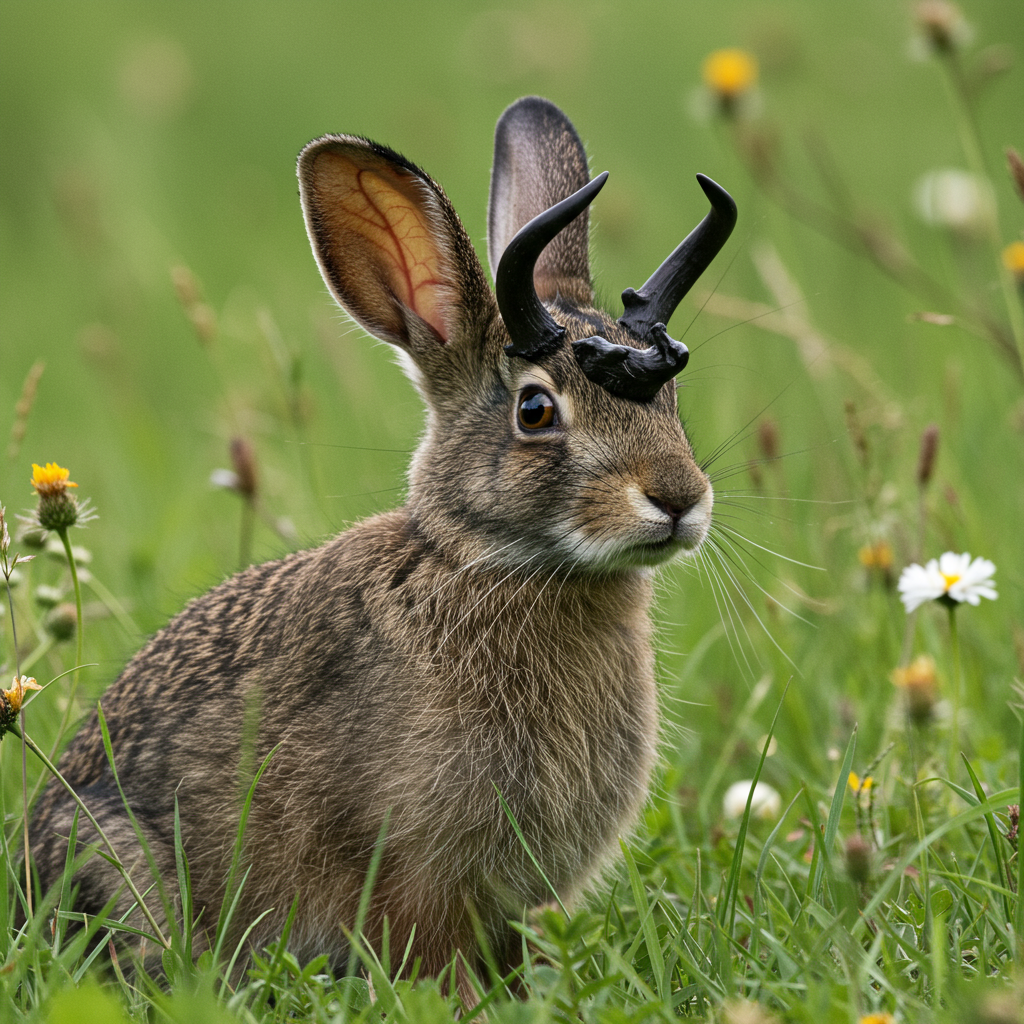Imagine encountering a wild rabbit, but something is startlingly different: strange, dark, horn-like growths protrude from its head, creating an almost alien appearance. Recent sightings across the U.S., particularly in Fort Collins, Colorado, have sparked both alarm and intense curiosity among residents. These unusual protrusions, often described as “quills” or “tentacles,” are not a sign of a new species or a horrific mutation, but rather a manifestation of a naturally occurring viral infection.
This article delves into the science behind these bizarre growths, known as Shope papilloma virus, and explains why, despite their alarming appearance, they are usually harmless to the wild animals themselves. We’ll explore how the virus spreads, its impact on both wild and domestic rabbits, and what the public should do if they encounter one of these unexpectedly horned creatures. Understanding this condition is key to appreciating the complex world of wildlife health and dispelling unwarranted fears.
What Are These Mysterious Growths?
The sight of a wild rabbit with such unusual formations can be quite unsettling. Eyewitness accounts from Fort Collins, Colorado, paint a vivid picture. Local resident Susan Mansfield, for example, described seeing a rabbit with what looked like “black quills or black toothpicks sticking out all around his or her mouth,” noting that the growths persisted and even enlarged over a year. Other descriptions have likened the affected rabbits to “Frankenstein” creatures or “zombie” entities due to the black, hardened masses distorting their faces.
Visual Description and Resident Accounts
These growths are technically known as keratinized papillomas. Initially, they might appear as “raised, red, and rough” lesions, typically over one centimeter in length. While most commonly observed on the head, these wart-like tumors can also emerge on the ears, eyelids, neck, shoulders, abdomen, thighs, and even the feet. Over time, they harden and turn black, taking on the distinct horn-like or tentacle-like appearance that has captivated and concerned observers. The startling visual impact often leads people to believe the animal is severely suffering or carries a highly contagious, dangerous disease.
The Culprit: Shope Papilloma Virus Explained
The underlying cause of these unsettling growths is a specific viral infection: the Shope papilloma virus, also known as Cottontail Rabbit Papillomavirus (CPRV). This DNA virus is responsible for benign tumors that develop on the skin of infected rabbits. According to experts like Colorado Parks and Wildlife (CPW) and Pet MD, these are essentially large warts, similar in nature to benign cancerous cells, though they are not always malignant. The growths are a result of the virus causing an overproduction of keratin, the same protein that makes up hair and nails, leading to the hard, horn-like texture. There is currently no known cure for the Shope papilloma virus itself in wild populations.
Impact on Wild and Domestic Rabbits
While the appearance of a rabbit with these growths can be quite disturbing, the Shope papilloma virus typically has a surprisingly limited impact on the health of wild rabbits. However, the situation can be more severe for domestic pets.
Harmless for Wild Rabbits? Understanding the Prognosis
For most wild cottontails, the Shope papilloma virus is generally considered harmless. The growths usually have no significant detrimental effects unless they physically interfere with the animal’s ability to eat, drink, or see. If the papillomas grow large enough to obstruct the mouth, eyes, or nostrils, they can impede essential functions, potentially leading to starvation or impaired vision.
However, the good news is that the majority of infected wild rabbits are able to survive the viral infection. In many cases, the growths will eventually regress naturally over time, and the rabbit will recover. This natural resolution is why CPW advises against euthanizing wild rabbits with papillomas unless their basic survival functions are severely compromised. It’s a testament to nature’s resilience that these animals often overcome such a visually striking ailment on their own. It’s important to note, however, that in some instances, these warts can progress into squamous cell carcinoma, a more serious form of skin cancer.
Threat to Pet Rabbits and Prevention
While wild rabbits often recover, the Shope papilloma virus poses a more significant risk to domestic rabbits. If a pet rabbit becomes infected, the disease tends to be more severe than in its wild counterparts. This difference in severity is likely due to varying immune responses or differences in viral strains. If a domestic rabbit exhibits these growths, veterinary attention is crucial for proper diagnosis and potential treatment.
Prevention is key for pet rabbits. Since the virus is transmitted primarily through the bites of infected insects, experts recommend keeping pet rabbits indoors to limit their exposure to pests like mosquitoes and ticks. Ensuring a pest-free environment for outdoor enclosures, if applicable, is also vital. This proactive approach significantly reduces the risk of domestic rabbits contracting CPRV.
Transmission and Seasonal Patterns
Understanding how the Shope papilloma virus spreads is crucial for both public awareness and domestic rabbit owners. The virus is highly species-specific, meaning it cannot be transmitted to humans, dogs, or other non-rabbit species. This fact should alleviate any public health concerns regarding the “zombie” rabbit sightings.
The primary mode of transmission is not direct contact between rabbits. Instead, the virus is spread through the bites of infected arthropods, primarily mosquitoes and ticks. These biting insects act as vectors, picking up the virus from an infected rabbit and then transmitting it to another susceptible rabbit during feeding. This vector-borne transmission explains why outbreaks of Shope papilloma virus are more prevalent during the summer and autumn months. This seasonality aligns with the peak activity periods of mosquitoes and ticks, making rabbits more susceptible to infection during these warmer times of the year.
What to Do if You Spot an Infected Rabbit
Given the alarming appearance of these “horned” rabbits, it’s natural for people to feel concern or a desire to help. However, the consistent advice from wildlife experts, including Colorado Parks and Wildlife, is to avoid direct interaction.
If you encounter a wild rabbit exhibiting these horn-like growths, the best course of action is to simply leave it alone. Do not attempt to approach, touch, feed, or capture the animal. Not only does this prevent unnecessary stress to the rabbit, but it also minimizes any potential, albeit extremely low, risk of indirect transmission (e.g., if you then handle your own pet rabbit without proper precautions, though the primary risk is insect-borne). Remember, the virus is not dangerous to humans or other pets, and for most wild rabbits, nature will take its course, with the growths eventually regressing. While not always required, reporting sightings to local wildlife authorities, like CPW, can help them monitor wildlife diseases and track prevalence.
Frequently Asked Questions
What causes the “horn-like” growths on wild rabbits?
The distinctive “horn-like” growths seen on wild rabbits are caused by the Shope papilloma virus, also known as Cottontail Rabbit Papillomavirus (CPRV). This virus leads to the development of benign skin tumors called keratinized papillomas. These growths are essentially large warts that become hard and dark due to an overproduction of keratin, the same protein found in hair and nails, giving them their unique and unsettling appearance.
What should I do if I encounter a wild rabbit with these growths?
If you spot a wild rabbit with these unusual growths, the most important advice from wildlife experts, such as Colorado Parks and Wildlife (CPW), is to leave the animal undisturbed. Do not attempt to approach, touch, feed, or assist it. The virus is not transmissible to humans or other species, and for most wild rabbits, the growths will eventually disappear on their own. Reporting specific sightings to local wildlife agencies can sometimes assist in monitoring wildlife health trends, but direct intervention is not recommended.
Is the Shope papilloma virus dangerous to domestic pets or humans?
No, the Shope papilloma virus is highly species-specific and does not pose a danger to humans, dogs, or other non-rabbit domestic pets. However, it can infect domestic rabbits, and the disease tends to be more severe in them, often requiring veterinary treatment. To protect pet rabbits, it’s advised to keep them indoors and safeguard them from biting insects like mosquitoes and ticks, which are the primary vectors for viral transmission.
Conclusion
The appearance of “horned” wild rabbits, though visually alarming, is a natural phenomenon caused by the Shope papilloma virus. While these peculiar growths can be unsettling to observe, they typically do not pose a significant threat to the survival of wild rabbits, with most animals recovering naturally over time. Crucially, the virus is not transmissible to humans or other species, dispelling widespread fears. Understanding this viral condition highlights the complexity and resilience of wildlife ecosystems. If you encounter one of these unique creatures, remember that the best course of action is to admire it from a respectful distance, allowing nature to take its course and ensuring the well-being of both the animal and yourself.




